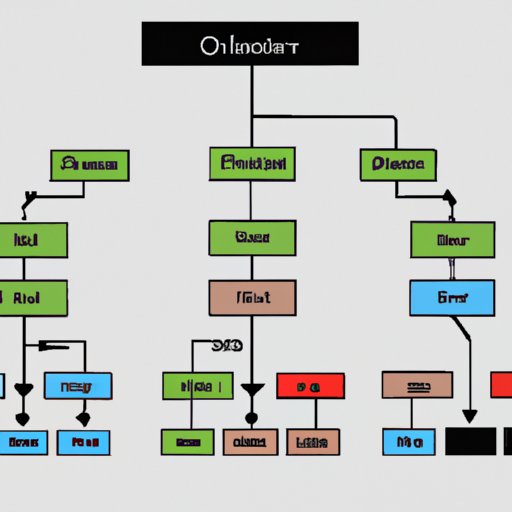Introduction
A diagram is an illustration that uses lines, shapes, and symbols to represent relationships or concepts. In science, diagrams are often used to explain complex concepts or processes. They can be used to illustrate chemical reactions, describe biological processes, or explain physical phenomena. By utilizing diagrams, scientists are able to better communicate their ideas and research findings to others.
In this article, we will explore what is a diagram in science and how diagrams are used to explain complex scientific concepts. We will look at the basics of science diagrams, the types of diagrams used in scientific research, and provide a comprehensive guide to constructing effective science diagrams.

Exploring the Basics of Science Diagrams
Diagrams are a powerful tool for communicating scientific ideas and research findings. They help scientists visualize data, simplify complex concepts, and make it easier to understand abstract ideas. By using diagrams, scientists can more effectively explain their research to others.
Diagrams can be used in many different ways in science. For example, they can be used to illustrate chemical reactions, describe biological processes, or explain physical phenomena. They can also be used to show the structure of molecules, display patterns in data, or demonstrate mathematical equations.
There are several types of diagrams used in scientific research. These include schematic diagrams, flow charts, concept maps, and statistical diagrams. Each type of diagram has its own purpose and can be used to convey different types of information.
Using diagrams in science education is also beneficial. Diagrams can help students better understand difficult concepts and visualize abstract ideas. By providing visual representations of scientific concepts, diagrams can help students learn more quickly and remember information more easily.

How to Use Diagrams to Explain Complex Scientific Concepts
Constructing effective diagrams is an important skill for scientists. An effective diagram should be clear, concise, and organized. It should also be easy to understand and provide all the necessary information.
When constructing a diagram, there are several components to consider. These include labels, arrows, and other symbols. Labels should clearly identify the elements of the diagram and help the viewer to understand the concept being illustrated. Arrows and other symbols should be used to show the relationships between various elements.
When creating diagrams that explain complex scientific concepts, there are a few tips to keep in mind. First, make sure the diagram is visually appealing. This will help the viewer to focus on the information being presented. Second, use simple language and avoid long, complicated explanations. Finally, create multiple diagrams if necessary to fully explain the concept.
A Comprehensive Guide to Constructing Effective Science Diagrams
Constructing effective science diagrams requires careful planning and consideration. Here is a step-by-step guide to constructing a science diagram:
- Step 1: Identify the purpose of the diagram.
- Step 2: Gather all the necessary information.
- Step 3: Organize the information into a logical sequence.
- Step 4: Create the diagram by drawing lines, shapes, and symbols.
- Step 5: Add labels, arrows, and other symbols to the diagram.
- Step 6: Review the diagram to ensure accuracy.
Examples of various types of diagrams used in scientific research can be found in textbooks, journal articles, and online resources. By looking at these examples, it is possible to get a better understanding of how diagrams are used in the sciences.
Common Types of Diagrams Used in Scientific Research
Here are some of the most common types of diagrams used in scientific research:
Schematic Diagrams
Schematic diagrams are used to illustrate the structure of a system or process. They are often used to depict the relationships between different elements of a system.
Flow Charts
Flow charts are diagrams that show the steps of a process. They are commonly used to demonstrate the logic behind computer algorithms and other complex processes.
Concept Maps
Concept maps are diagrams that show the relationships between concepts. They are often used to visualize the structure of a topic or field of study.
Statistical Diagrams
Statistical diagrams are used to display data in a visual format. They are commonly used to show trends or patterns in data sets.

Examples of How Diagrams are Utilized in the Sciences
Diagrams are used in many different areas of science. Here are some examples of how diagrams are utilized in the sciences:
- Illustrating chemical reactions – Diagrams can be used to show the reactants and products of a chemical reaction.
- Describing biological processes – Diagrams can be used to illustrate the various stages of a biological process such as photosynthesis or cell division.
- Explaining physical phenomena – Diagrams can be used to explain phenomena such as light refraction or electrical circuits.
Conclusion
Diagrams are a powerful tool for communicating scientific ideas and research findings. They can be used to illustrate chemical reactions, describe biological processes, or explain physical phenomena. They can also be used to show the structure of molecules, display patterns in data, or demonstrate mathematical equations. By utilizing diagrams, scientists are able to better communicate their ideas and research findings to others.
In this article, we explored what is a diagram in science and how diagrams are used to explain complex scientific concepts. We looked at the basics of science diagrams, the types of diagrams used in scientific research, and provided a comprehensive guide to constructing effective science diagrams. We hope this article has provided you with a better understanding of how diagrams are used in the sciences.
(Note: Is this article not meeting your expectations? Do you have knowledge or insights to share? Unlock new opportunities and expand your reach by joining our authors team. Click Registration to join us and share your expertise with our readers.)
